In today’s fast-paced world, municipalities and regulatory bodies are increasingly turning to technology to streamline their operations and ensure compliance with safety, building, and zoning codes. Code enforcement, which once relied heavily on manual processes, is now embracing digital transformation through advanced mobile apps. These Code Enforcement Apps are helping to revolutionize the way agencies monitor, enforce, and manage code violations. In this article, we’ll explore the industry’s requirements, current trends, and the latest news driving the evolution of code enforcement apps.
Get Started in Minutes — No Coding Required! |
https://axonator.com/request-for-demo/
Industry Requirements for Code Enforcement Apps
To understand the growing importance of code enforcement apps, it’s critical to know the baseline requirements demanded by the industry. At its core, a code enforcement app must be designed to simplify the enforcement process while maintaining accuracy and legal compliance. The following are some key requirements that industry professionals look for:
- Ease of Use: Code enforcement officers need an intuitive interface that allows them to access data quickly in the field. The app should be simple enough for officers with varying levels of tech proficiency to use with minimal training.
- Mobile Accessibility: Fieldwork requires a highly mobile solution. Code enforcement apps must function seamlessly on smartphones and tablets, providing officers with real-time access to information while in the field.
- Integration with Municipal Systems: These apps should integrate with existing city or municipal software solutions, such as Geographic Information Systems (GIS), permitting software, and public record databases. This integration ensures smooth data flow and more accurate enforcement.
- Automated Workflows: Automated features such as task assignment, scheduling inspections, and sending violation notices can drastically reduce the workload on code enforcement officers. It also improves consistency in code violation handling.
- Real-Time Reporting and Analytics: The app should allow officers to generate real-time reports and use analytics to track violation trends, monitor workloads, and optimize resources.
- Compliance Management: Legal compliance is key in code enforcement. The app must ensure that all actions taken are fully documented and comply with local, state, and federal laws.
Current Industry Trends in Code Enforcement Apps
The rapid digital transformation of code enforcement has led to several exciting trends within the industry. Here’s a closer look at some of the most prominent:
- Artificial Intelligence (AI) and Automation: AI is making waves in code enforcement apps, allowing for predictive analytics and more efficient enforcement strategies. AI can analyze historical data to predict which areas are more likely to violate codes, helping cities allocate resources more effectively.
- Drone Integration: Some code enforcement agencies are experimenting with drones to inspect properties in hard-to-reach areas. Drones can capture real-time aerial views, reducing the need for manual inspections. This is especially useful for tall buildings or unsafe zones.
- Cloud-Based Solutions: More municipalities are shifting to cloud-based code enforcement apps, allowing them to store vast amounts of data without investing heavily in hardware. Cloud technology also supports real-time data syncing between field officers and office administrators.
- Augmented Reality (AR): AR is being explored as a tool to visualize building codes and zoning regulations in real time. Officers could use AR-enabled code enforcement apps to overlay zoning and building plans on the physical world, instantly identifying violations.
- Public Access Portals: Transparency is another growing trend, with cities allowing citizens to report violations and track their progress through public access portals integrated with code enforcement apps. This not only promotes community involvement but also helps agencies respond more quickly to potential violations.
- Sustainability and Environmental Focus: Environmental regulations are now being factored into code enforcement more than ever. Apps are being designed to enforce eco-friendly building codes, monitor energy efficiency, and ensure sustainable urban development.
Latest News and Developments
The evolution of code enforcement apps continues to be driven by emerging technologies and shifting regulatory landscapes. Recently, several key developments have emerged:
- Increased Funding for Digital Solutions: Many cities across the U.S. and Europe have been allocated additional funding for digital infrastructure improvements, including code enforcement software. This is part of broader smart city initiatives aimed at modernizing urban management processes.
- New AI Tools for Predictive Enforcement: Companies are increasingly developing AI tools specifically tailored for code enforcement. These tools analyze large datasets, identify trends, and forecast future violations, helping cities make more proactive enforcement decisions.
- Legislative Support for Digital Transformation: Governments are starting to support the digitalization of code enforcement through new legislation. Several states have passed laws allowing cities to use digital evidence, such as drone footage or data from code enforcement apps, in court cases regarding code violations.
- Cybersecurity Enhancements: With more municipalities relying on cloud-based enforcement apps, data security is becoming a top priority. Developers are focusing on incorporating advanced cybersecurity measures, such as encryption, two-factor authentication, and regular software updates, to protect sensitive municipal data.
Learn More | https://axonator.com/app/code-enforcement-app/
The Future of Code Enforcement Apps
Looking forward, the code enforcement industry is poised to embrace even more advanced technologies. The integration of 5G networks will allow for faster data transfer and real-time collaboration between officers, administrators, and even other city departments. Blockchain could also play a role in ensuring the integrity of code violation records, making it impossible to tamper with reports or inspection outcomes.
The industry will also likely see more user-friendly, low-code platforms that allow municipalities to customize apps according to their unique needs without requiring deep technical expertise. As technology continues to evolve, code enforcement apps will become even more central to ensuring safer, more compliant urban environments.
About Axonator Inc:
At Axonator, Our vision is simple yet powerful: to enable the world on mobile. We envision a future where every aspect of business and society is seamlessly connected through mobile devices. Our mission is to empower businesses worldwide to leverage the full potential of mobile technology, transforming the way they operate, communicate, and collaborate.
Contact:
Axonator Inc (The World On Mobile)
Austin, TX, USA
USA: +1–716–274–8885
India: +91–8600–032–635
Email: support@axonator.com
Website: https://axonator.com/









